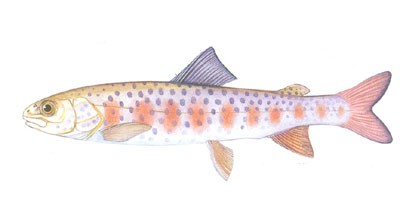Qinling lenok tsinlingensis (Brachymystax lenok tsinlingensis) belongs to the order Salmoniformes, family Salmonidae, and genus Brachymystax lenok tsinlingensis. Commonly known as: flower fish, plum blossom fish, gold plate fish, Lu flower fish, five-color fish, Lu fish. English name: Qinling lenok.
Endangerment level: Vulnerable. China's national level II protected wildlife.
The body is long and spindle-shaped, slightly flattened laterally. The head is blunt, the back of the head is broad, and the center is slightly convex. The muzzle is not prominent or slightly projecting. At the end of the mouth, the lower jaw is slightly shorter than the upper jaw, and the back end of the maxilla reaches below the center of the eye. The upper and lower jaws, vomer and palatine bones each have one row of canines. The tongue is thick and free, with about 10 radula teeth arranged in a "∧" shape. Big eyes. The gill openings are large. The branchial membrane is not connected to the isthmus. The scales are small and the lateral lines are complete and straight. The dorsal fin is short and the outer edge is slightly concave; the adipose fin is opposite to the anal fin; the pelvic fin extends backward and does not reach the anus, and there is a long axillary scale at the base of the fin; the caudal fin is forked. There are 65-75 pyloric caeca. The back of the body is dark brown, and gradually turns white from the sides to the abdomen. There are long oval black spots scattered on the back and both sides of the body. The edges of the spots are light red rings. There are 4-5 round black spots along the base of the dorsal fin and on the adipose fin. .

It is a remnant species that migrated from the north to the south during the Ice Age. It is a cold-water foothill fish. It lives in mountain streams at an altitude of 900-2,300 meters in the Qinling Mountains. The water flow is fast, the water quality is clear, and the bottom is mostly large gravels. In late autumn, they overwinter in deep pools or deep troughs of rivers. Except during flood periods, it is rarely seen in the main streams of the plains. It is a carnivorous fish. Young fish mainly feed on aquatic invertebrates. In addition to fish, adults also eat terrestrial insects blown down by the wind. Feeding time is mostly concentrated in the morning and evening. Feeding activities are frequent on cloudy days and can be seen throughout the day. The initial age of sexual maturity is 3+-5+ years. Sexually mature individuals lay eggs in February-March, and the spawning grounds are mostly on the sandy bottom of shallow water. The spawning water temperature is below 10℃. The absolute pregnancy capacity is 2670-4510 eggs. The eggs are deposited and discharged in one go.
The Qinling slender salmon is unique to my country and is only distributed in the upper reaches of the Wei River and its tributaries and the streams in the upper reaches of the Sushui River and Ziwu River, the northern tributaries of the Han River. Common individuals are mostly around 150 mm, and can reach up to 450 mm. Because the fishery production in the production areas is extremely backward, and the phenomena of poisoning, electrocution, and explosion are very serious, as a result, in areas with a large population below an altitude of 1,200 meters, the amount of resources has decreased sharply, and most of the fish that can be seen are 2+-3+ years old. There are still a certain number of immature individuals in sparsely populated areas above 1,200 meters above sea level. The Qinling squid is listed as a national grade II wild protected animal.
animal tags:
We created this article in conjunction with AI technology, then made sure it was fact-checked and edited by a Animals Top editor.